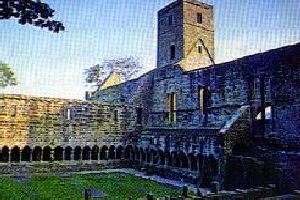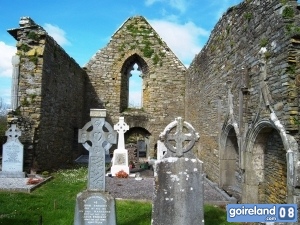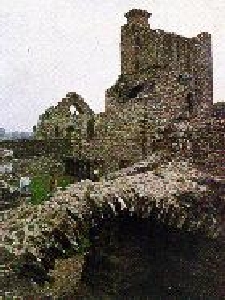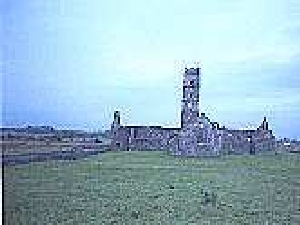The legacy of being the land of saints and scholars are the wonderful religious monuments and shrines located all over Ireland. Here are a list of some of the top attractions in this genre.
Sligo Abbey 
Sligo Abbey was founded in 1252 or 1253 for the Dominicans by Maurice Fitzgerald, 2nd Baron of Offaly, who was also founder of the town. Having escaped the ravages suffered by the now destroyed Sligo Castle in the 13th and 14th centuries, the Friary was accidentally burned in 1414, but was rebuilt two years later by Friar Bryan MacDonagh with assistance from Pope John XXIII.
In 1568 O’Conor Sligo made a petition to Queen Elizabeth not to dissolve the Friary, and this was granted on the condition that the friars became secular clergy. When George Bingham was besieging the castle nearby, he occupied and badly damaged the buildings. The Friary was burned in 1641 by Sir Frederick Hamilton, and it was afterwards granted to Sir William Taffe.
The church has a nave with side aisle and a south transept. The choir, with its eight lancet windows, is the oldest part of the church and dates to shortly after the foundation. The 15th century east window replaced the original three lancet windows.
Lislaughtin Franciscan Friary, Kerry 
John O’Connor founded this Friary for the Franciscans in 1478 which is thought to be on the site of an older monastery founded by St. Lachtin (died 622). It consists of a long church with north transept and some domestic buildings. The west window of the church has an attractive flame-like form. There are two tomb-niches in the nave and a triple sedilia in the choir. Around the cloister can be seen the remains of domestic buildings, including the refectory on the east side, with the dormitory above.
At the north end is a tower which housed the lavatories. The gateway leading from the outside to the monastic enclosure is still preserved. After the Dissolution of the Monasteries, some of the friars probably remained on, and we know that in 1580 three friars were strangled in front of the High Altar. The Franciscans formally regained possession again in 1629, but when they finally left no one knows.
Lislaughtin is located 5km West from Tarbert, taking the Coast Road and 3km East form Ballylongford taking the Coast Road.
Ennis Friary 
The Ennis Friary, is a Franciscan Friary founded by the O’Briens Kings of Thomond, in the 13th century. The site was originally on an island in the River Fergus around which the modern town of Ennis has grown. Its most famous landmarks include the McMahon tomb (15th century) with carvings of the Passion of Our Lord.
Open daily Mid May to September inclusive 9.30am to 6.30pm, and at other times by pre-arrangement.
Muckross Friary, Killarney
The Franciscan Friary was founded in the 15th century and is in a remarkable state of preservation. The tower was added after the church was built and is the only Franciscan tower in Ireland which is as wide as the church. The cloister and its associated buildings are complete and an old Yew Tree stands in the centre. The monks were finally driven out by the Cromwellians in 1652.
There are guided tours available on request and there is a public car park close to the site.
The average length of visit is 30 minutes. There is limited access for visitors with disabilities and guide dogs permitted.
Creevelea Franciscan Friary, Leitrim 
This Franciscan Friary, founded by Owen O’Rourke and his wife Margaret in 1508, was the last Franciscan friary to be founded in Ireland before the Suppression of the Monasteries. The church has a nave, choir, tower and south transept. The west doorway and the window above it are well preserved, as is also the east window, but the windows in the south transept have vanished. The transept has a number of recesses. The tower was converted into living quarters in the 17th century. To the north of the church a number of domestic buildings surround the cloister.
The cloister is irregular in shape, and in the centre of the north side there are a number of interesting carvings on the pillars. One of these shows St. Francis with the stigmata, and with an inscription crossing his body. Another shows the same saint in a pulpit with birds perched on a tree; legend says that he understood the language of the birds. On the east side of the clositer are three rooms, that nearest the church being a sacristy, and beyond these rooms is a passage joining the cloister with the outside world.
Kilconnell Friary, Galway 
This Franciscan Friary was founded in 1353 on the site of an older monastery founded by St. Conall in the sixth century. The buildings consists of a church with nave, choir, south transept and aisle, and some domestic buildings.
There are two fine tomb niches in the north wall of the church. Tradition says that the friars were expelled from the monastery only a few weeks before the Battle of Aughrim in 1691.
Quin Friary, Clare
A church which stood on the site was burned in 1278, but two years later DeClare built it up as a castle forming a square with massive rounded towers at the corners. Parts of these towers still survive. In 1236 the garrison killed an Irish chief called O’Liddy, whereupon the Irish under Cuvea Macnamara attacked and ransacked the castle.
By 1350 another church was built on top of the castle ruins, but much of this church was renewed by Sioda Cam Macnamara around 1433 when the Franciscans were brought to Quin. The church has a tower and well-preserved east, west and south windows, and a south transept. The cloisters are some of the best-preserved Franciscan examples in the country, with a dormitory on the first floor. In the church there is an interesting collection of 15th-19th century tombstones. St. Finghin’s Church: On the other side of the stream is St. Finghin’s Church, built between 1278 and 1285. It is a long rectangular church with triple lancet windows and the remains of a richly moulded south window.
Nenagh Castle & Franciscan Friary
The present massive tower, or donjon, was originally one of three towers interspersed in the curtain wall of a strong Norman castle which was also guarded by two semicircular towers and a gatehouse (parts of which remain to the south of the tower). The tower has 5 storeys, and the walls are up to 20 feet thick. A southern window-niche opening off the second floor has Romanesque decoration on the inside, while there is early Gothic decoration on a chimney piece in the floor above.
The castle was founded by Theobald Walter (nephew of Thomas a Becket) in the first twenty years of the 13th century. The Butlers resided here continuously till towards the end of the 14th century when they moved to Gowran, in Co. Kilkenny. during the 15th century it was in the hands of the MacIbrien family, but by 1533 Sir Piers Butler, Earl of Ossory, had returned to regain possession. However, in 1548 the Irish, under O’Carroll, burned it. By the latter half of the 16th century the Butlers had fully regained possession, but James I granted the castle to Lady Dibwall.
